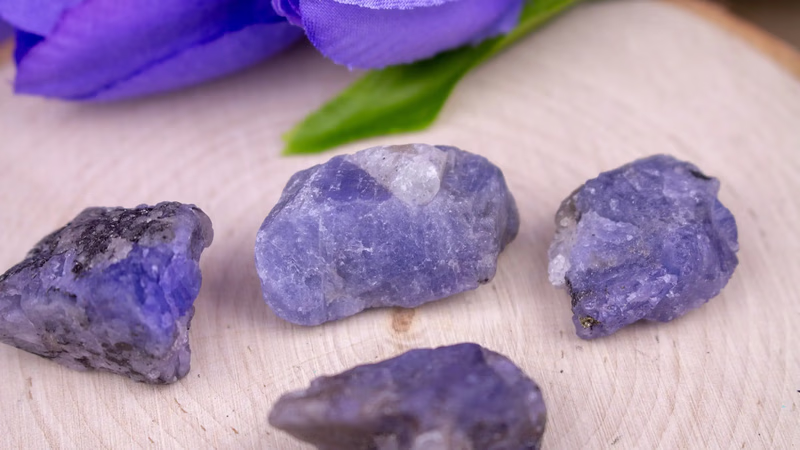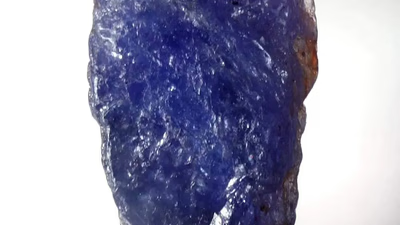
Tanzanite gemstones showcase stunning colors and pleochroic effects.
Tanzanite is renowned for its stunning blue and violet hues, but it can exhibit a range of colors due to its pleochroic nature, which means it can show different colors when viewed from different angles. Blue Tanzanite is the most popular and valued color of tanzanite. The blue can range from a light, sky-blue to a deep, rich cobalt blue. The depth of blue often increases with the size of the gemstone. Larger stones tend to exhibit more intense blue hues. Violet tanzanite displays a range of purples, from light lilac to deep violet. This color is also highly prized, though not as much as the deep blue variety. The violet color can often be seen alongside blue in pleochroic stones, adding to the gem’s unique visual appeal.
Green tanzanite, also known as "chrome tanzanite," is rarer and exhibits shades of green due to trace amounts of vanadium. While less common, green tanzanite is not as highly valued as the blue or violet varieties. Untreated tanzanite can exhibit brown or yellow hues. These colors are typically transformed into blue or violet through heat treatment. These colors are less desirable in the market and are often subjected to heat treatment to enhance their appeal. Natural (Untreated) Tanzanite is in its natural state without any heat treatment.
Tanzanite’s captivating range of colors and types makes it a versatile and highly desirable gemstone. Whether in its deep blue, vibrant violet, or rarer hues, each piece of tanzanite offers a unique beauty. Understanding the various colors and types, along with their respective market values, can help buyers and enthusiasts appreciate the full spectrum of this remarkable gemstone. Tanzanite is multicolored, which means that it shows different colors depending on the viewing angle. In order to get the best blue or violet blue color, the gem cutter must cut the right angle. The dark blue of tanzanite can resemble sapphire, which is why this stone is so popular. The extraordinary color of tanzanite becomes more colorful after heating and its brown tone disappears.
Tanzanite is one of the minerals that was first discovered in Tanzania and is the only source so far. This gemstone belongs to the Zosite group of minerals with the chemical formula, calcium aluminum silicate, which has a hardness of 6.5 to 7. Tanzanite stone is blue and purple in color, but according to the light source, similar to Alexandrite stone, it shows different colors, which is due to the presence of vanadium in it. The dark blue color of tanzanite stone is similar to sapphire, which becomes darker after heating.
Royal Blue Stones in 1970 with low capacities soon attracted the attention of American and European advertisements. When the new gemstone word came out, Henry Platt of the Tiffany Company named the new gemstone tanzanite, and Tiffany began a marketing campaign to introduce it to the public. Currently, tanzanite is the pride of the African country of Tanzania. Of course, after word of this precious stone got out, a deadly attack quickly put an end to the mineral's exploitation. A fake car accident in which D'Souza was killed interrupted the pursuit and extraction of any reserves. As a result, during these two years, the reserves were not able to maintain the demand.
Untreated tanzanite is rare and can be prized by collectors, though it’s less commercially popular than treated stones. The majority of tanzanite on the market has been heat-treated to enhance its blue and violet hues. The treatment is stable and permanent. Heat-treated tanzanite is highly sought after due to its vibrant color and is the most commonly available type. Cat’s Eye Tanzanite is a chatoyant effect, where a single band of light can be seen moving across the surface, resembling a cat’s eye. Cat’s Eye tanzanite is valued for its unique optical phenomenon, although it is quite rare.
Bi-color tanzanite displays two distinct colors within the same stone, typically blue and violet. The colors can be seen either as zones within the crystal or as a gradient. This type can be particularly interesting to collectors and enthusiasts due to its unique and striking appearance. Tanzanite’s pleochroic nature means it can show different colors such as blue, violet, and burgundy when viewed from different angles. This is due to the way the crystal absorbs light. The color of tanzanite can appear different under various lighting conditions. Incandescent light tends to bring out the violet hues, while fluorescent light highlights the blue tones. The way a tanzanite is cut can influence its apparent color. Skilled cutters optimize the stone’s orientation to enhance its most desirable colors.
-

Tanzanite stones are valued for their vibrant blue and violet hues, with high-quality specimens exhibiting strong pleochroism and minimal inclusions. The clarity, cut, carat weight, and certification from reputable gemological laboratories are crucial factors in determining the stone"s value. Authentic tanzanite is exclusively sourced from Tanzania, making verification of origin essential. Larger stones with deep colors are generally more valuable, but quality should not be compromised for size. The gemstone"s hardness ranges from 6 to 7 on the Mohs scale, indicating it may be prone to scratches and damage, which makes it less suitable for everyday wear. Buyers should inspect tanzanite using a jeweler’s loupe to check for clarity and any visible flaws. Comparing multiple stones can help assess color saturation and quality. Genuine tanzanite displays different colors under varying lighting conditions and may exhibit a soft glow under UV light.
Most tanzanite is heat-treated to enhance color; untreated stones are rare and can have different values. A gemological report is essential for confirming authenticity and detailing any treatments the stone has undergone.
-

Tanzanite is a unique blue to violet gemstone, a variety of zoisite, discovered in Tanzania"s Mererani Hills. Its striking color can change based on crystal orientation and lighting, a phenomenon known as pleochroism. First found in 1967 by a Maasai tribesman, tanzanite gained popularity through Tiffany & Co. , which named it after its origin. The gemstone"s rarity stems from its exclusive source, making it highly desirable. With a hardness of 6. 5 to 7 on the Mohs scale, tanzanite is somewhat vulnerable to scratches and requires careful handling. Most stones available today are heat-treated to enhance their color, which ranges from brownish to greenish before treatment.
The value of tanzanite is determined by its color, clarity, cut, and carat weight; deep blue or violet stones without inclusions are the most sought after. Despite being relatively new to the market compared to other gemstones, tanzanite"s unique beauty and limited availability contribute to its growing popularity. "
-

Tanzanite is a unique gemstone known for its captivating blue and violet hues, which can vary based on viewing angles due to its pleochroic nature. The most sought-after color is deep blue, with larger stones exhibiting more intense shades. Violet tanzanite, while also valued, is less popular than the blue variety. Green tanzanite, or "chrome tanzanite," is rarer and less valued compared to its blue and violet counterparts. Untreated tanzanite can show brown or yellow hues but is often heat-treated to enhance its appeal. The gemstone"s origins trace back to Tanzania, where it was first discovered and named by Tiffany & Co. in the 1970s. The market primarily consists of heat-treated stones due to their vibrant colors, while untreated stones are prized by collectors for their rarity.
Cat’s Eye tanzanite features a unique optical effect resembling a cat"s eye and is highly sought after despite its rarity. Bi-color tanzanite displays two distinct colors within the same stone, making it particularly appealing to collectors. Understanding the various types of tanzanite and their market values can help buyers appreciate this remarkable gemstone"s full spectrum. "
-

The value of tanzanite is determined by factors such as color, clarity, cut, carat weight, and certification. The most sought-after tanzanite displays a deep blue or violet-blue hue, with high color saturation significantly enhancing its value. Clarity is crucial; eye-clean stones are more valuable than those with visible inclusions. The quality of the cut also affects the stone"s brilliance and overall appeal. Larger tanzanite stones tend to be more valuable, especially if they maintain good color and clarity. Certification from reputable gemological laboratories can increase market value due to verified authenticity. Tanzanite is rarer than diamonds but generally costs much less, with prices ranging from $200 to $2,000 per carat based on quality. Market demand and supply limitations from its exclusive mining location in Tanzania further influence pricing dynamics.
Retail prices often include markups compared to wholesale prices, making it essential for buyers to purchase from reputable sources. "
-

Tanzanite is exclusively found in a small region of northern Tanzania, specifically near the Mererani Hills in the Simanjiro District. This area, approximately 7 kilometers long and 2 kilometers wide, is close to Arusha and Kilimanjaro International Airport, making it relatively accessible. The gemstone"s rarity stems from its limited geographic range, contributing to its high value. As resources diminish due to excessive extraction, prices are expected to rise significantly over the next 20 to 25 years. The Great Rift Valley, which stretches from Syria to Mozambique, plays a crucial role in the geological formation of tanzanite through volcanic activity and tectonic movements. The Tanzanian government has divided mining operations into four blocks, with large operators controlling two blocks while local miners work the others. Mining conditions are challenging due to depth and rock hardness, requiring both artisanal and commercial extraction methods. Tanzanite exhibits strong pleochroism, displaying different colors from various angles, typically blue, violet, and burgundy hues.
Most stones undergo heat treatment to enhance their color. "





